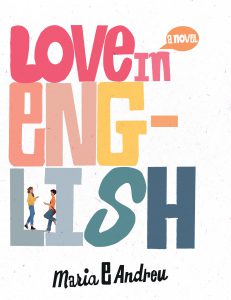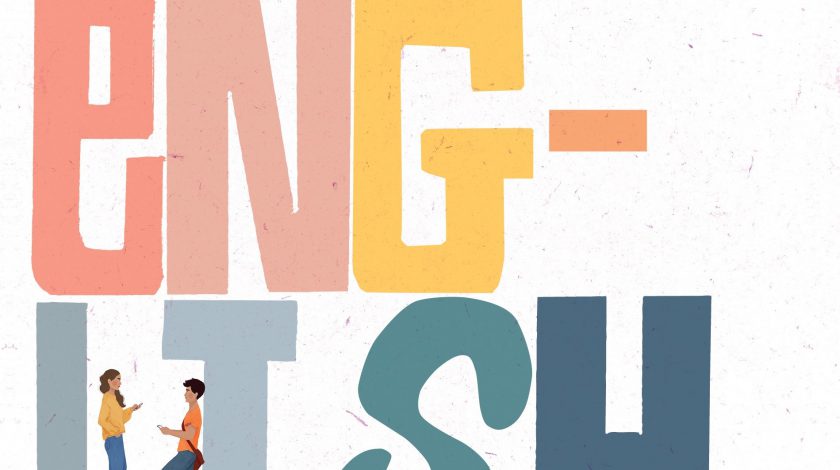Fifteen Reasons to Love the Novel, Love in English
- It’s dedicated to “everyone who has ever strained to find the [right] words” to accurately express their thoughts and feelings.
- Maria E. Andreu writes with authenticity from the immigrant experience and perspective, but she also writes to those of us who feel “foreign” or who sense a feeling of other—“some nameless thing [we] can feel but not fix” (13).

- Many of the chapters close with idiomatically clever poems as the protagonist, Ana, plays with language. These not only capture her confusion but convey her learning.
- The novel is peppered with Spanish, as well as hashtags (####) whenever Ana is confused by idioms, colloquialisms, unknown words, or fast talkers—what she describes as “undecipherable noise.”
- The characters are drawn with such depth; everyone needs a “parent-whispering, Dad-girlfriend-avoiding, old-lady-driving, green-fingernailed, crazy-haired friend [like Altagracia] who can make you laugh at anything” (134) and who exudes limitless confidence and always looks video-ready. This outrageous and outgoing gal has a soft and beautiful heart under a hard shell.
- It features Harrison, who is “Netflix-series handsome” and sends Ana “Somewhere to tight-throat/shallow-breath land. Somewhere to ohmygodthatcurlbyhisear land” (136). Harrison is one leg in a love-triangle, the character who makes Ana an origami crane—Ana’s first tangible sign of friendship. Later, the cranes come to represent “a beautiful, papery reminder that love comes in many languages and shapes, and that small things can add up to a garden full of beautiful” (240).
- Andreu, so precisely and with just the right amount of humor, captures Ana’s (of Argentinian descent) and Neo’s (of Greek descent) frustration with English as a second language: “For every word I get out, there’s a whole iceberg of thoughts and hopes and feelings that stay unspoken. But how do I speak them?” (137). Still, “in a place where she is too nervous to speak, it feels good to write” (30).
- Coming to another country doesn’t have to mean erasing everything about one’s identity. Coming to American may have brought a “bigger life” for Ana, but not necessarily a better life.
- “The stories we tell ourselves make us who we are” (202), and many of these stories are connected to rituals and customs, which bring comfort and something to believe in or to rely on.
- Andreu shares an intriguing perception of art. The thing Ana likes about art is that she can shut off her brain for a time and just draw. There’s no talking, not too much trying to understand. The teacher simply demonstrates a technique—such as shading—and she imitates it. The technique might be difficult, but it is “an easy kind of hard, the kind with no consequences” (57).
- Language may behave like an unfriendly maze, but eventually, Ana finds her way. Ultimately, she realizes that “the most important words are the ones we’re brave enough to share” (251).
- Through Ana, the reader will wonder about words: Which word captures who you are? For Ana, it’s yearning—“that tangled up feeling of wanting someone or something to be near you, to be yours, and the more you try to escape the thoughts, the more they come. I am a whole ball of yearning, for home, for words” (232). We might even be inspired to keep our own “Glossary of Happiness.”
- Andreu captures the confusion of liking two boys at once and the frustration that relationships don’t come with instructions.
- We all make mistakes; “it’s what we do after mistakes that show who we are” (294).
- From Andreu’s characters, we might be inspired to find our voice, recognizing that the process is about more than just memorizing all the right words but about saying them when they can make a difference. Although words may be tools of communication, behind them lies our identity, our experiences, and our sense of being. So, while “this is a story of wanting to find yourself, of feeling excluded, or worrying whether you’re enough, it is also about how the people we meet and love and need on the journey mean everything. There is no language and every language for that” (320).
- Posted by Donna


Thanks so much for this list! I love it!
You are entirely welcome, Maria! The teacher in me sees so many teachable moments in this book. I have written Honoring Identities: Creating Culturally Responsive Learning Communities (Rowman and Littlefield, 2021), and we share some similar philosophies for sure!